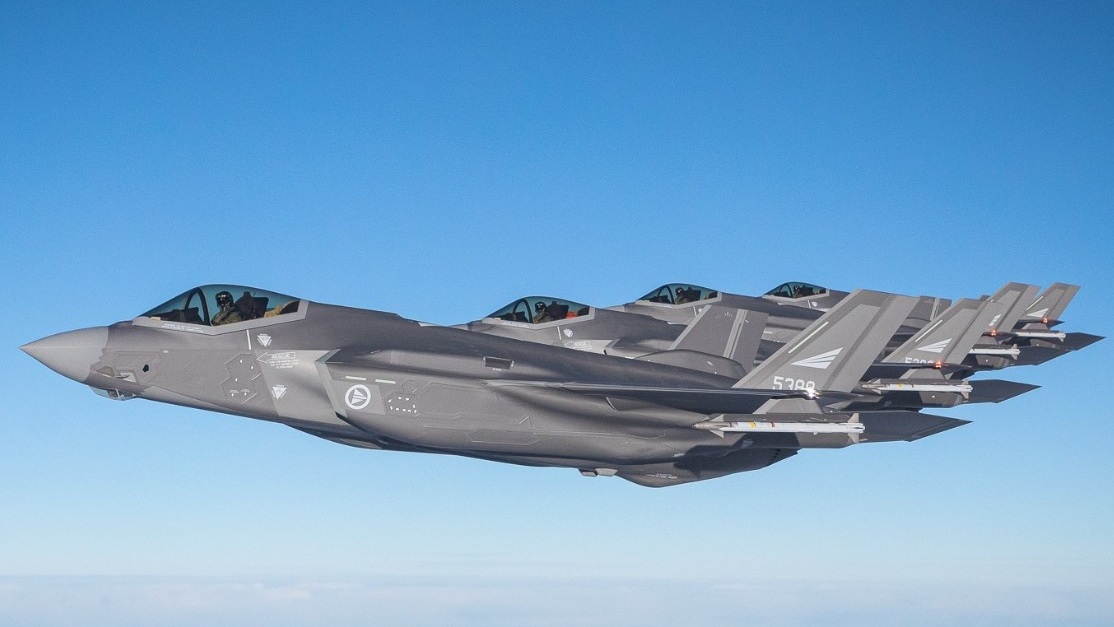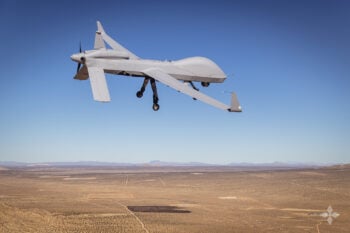
A fleet of four Royal Norwegian Air Force fighter jets take to the sky (Royal Norwegian Armed Forces)
BELFAST — Norway will double its military budget over the next 12 years by increasing spending by 600 billion NOK ($56 billion), part of a “historic” new defense plan announced today by Prime Minister Jonas Gahr Støre that prioritises heavy investment in new frigates and submarines to push back against Russian maritime influence in the High North and Atlantic Ocean.
“This plan represents a historic boost in defence spending, and involves a significant strengthening of all branches of the Armed Forces,” Støre is quoted as saying in a Norwegian government statement published on Friday to launch the defense plan.
“The Norwegian government proposes to spend a total of NOK 1.6 trillion ($150 billion) on Norway’s defence over the next twelve years, until 2036,” noted the statement. “By then, the defence budget will be almost twice as large as it is today, measured in real value.”
The proposed spending uplift is subject to parliamentary approval.
Oslo also said that “in terms of money, the strengthening of the Navy is the largest investment in this long-term plan,” with maritime modernization efforts dominated by development of a new naval surface fleet. It includes the acquisition of at least five new frigates, accompanied by anti-submarine helicopters. Norway’s subsurface fleet will also be boosted by procurement of five new submarines, at a minimum.
In practice, this would mean acquisition of another Type 212CD vessel, with four of the German-designed subs already on order. The fleet are part of a joint German-Norwegian program, in partnership with shipbuilder ThyssenKrupp Marine Systems. A first Norwegian sub underwent construction at the company’s Kiel yard in September last year.
In both cases relating to frigates and submarines, the proposed hull count of five sits below the six recommended by Norway’s Chief of Defence, Gen. Eirik Kristoffersen, in a “Military Advice” report published last year. The plan still strongly aligns with his support for the elimination of structural armed force weaknesses, maritime surface improvements, an uplift in air defense capabilities and long range precision fires.
Norway currently operates four Fridtjof Nansen frigates, though the defense plan does not include details of a replacement program.
At a strategic level, the new document says that “maintaining situational awareness in the High North and in the North Atlantic is paramount” because of Norway’s closeness to Russia’s nuclear submarine fleet. It further adds, “The rise of China is asserting pressure on the prevailing world order and an assertive Russia is challenging the Euro-Atlantic security architecture. This recognition is a an important premise for the choices made in this plan.”
Taking a positive view of recent strategic changes in the Nordics, Bjørn Arild Gram, Norway’s defense minister, said that Sweden and Finland’s entry to NATO “is a strength to security in our region.”
The defence plan also signals a strengthening of Norwegian air defence capabilities — led primarily through the acquisition, for the first time, of a long-range, ground based air defense system (GBAD), an expansion of the army to three brigades instead of one, and an additional 45,000 soldiers for the Home Guard.
Future procurement of “long-range air defence systems to protect against short-range ballistic missiles” is also planned, while air defense capabilities are due to be improved under an effort to double the number of National Advanced Surface-to-Air Missile Systems (NASAMS) made by Norway’s Kongsberg.
In a NOK 1.4 billion ($130 million) deal, the Norwegian Defence Material Agency ordered new NASAMS from the manufacturer in January to replace systems supplied to Ukraine. At the time, Kongsberg said deliveries would run from 2026 to 2027.
Oslo also noted today that NASAMS will be upgraded to protect against enemy drones and missiles.
Under the long-term defense plan, new army and special forces investments will predominately cover “long-range precision firepower, additional combat vehicles, air defence and helicopters,” according to the government statement.
Additionally, it says that situational awareness around “surrounding areas” of Norway will be enhanced through the expansion of satellite and drone capabilities. Specifically, collaboration with international allies will lead to Norway acquiring long-range drones to monitor “maritime areas of interest” in the High North.
Norway’s efforts to increase military capabilities across all domains comes on the heels of NATO’s two-week Nordic Response training exercise, held in March, a show of strength by allied nations to prepare for war against Russia and that comprised of 20,000 troops from 12 nations.
TAI exec claims 20 Turkish KAAN fighters to be delivered in 2028
Temel Kotil, TAI’s general manager, claimed that the domestically-produced Turkish jet will outperform the F-35 Joint Strike Fighter.


























